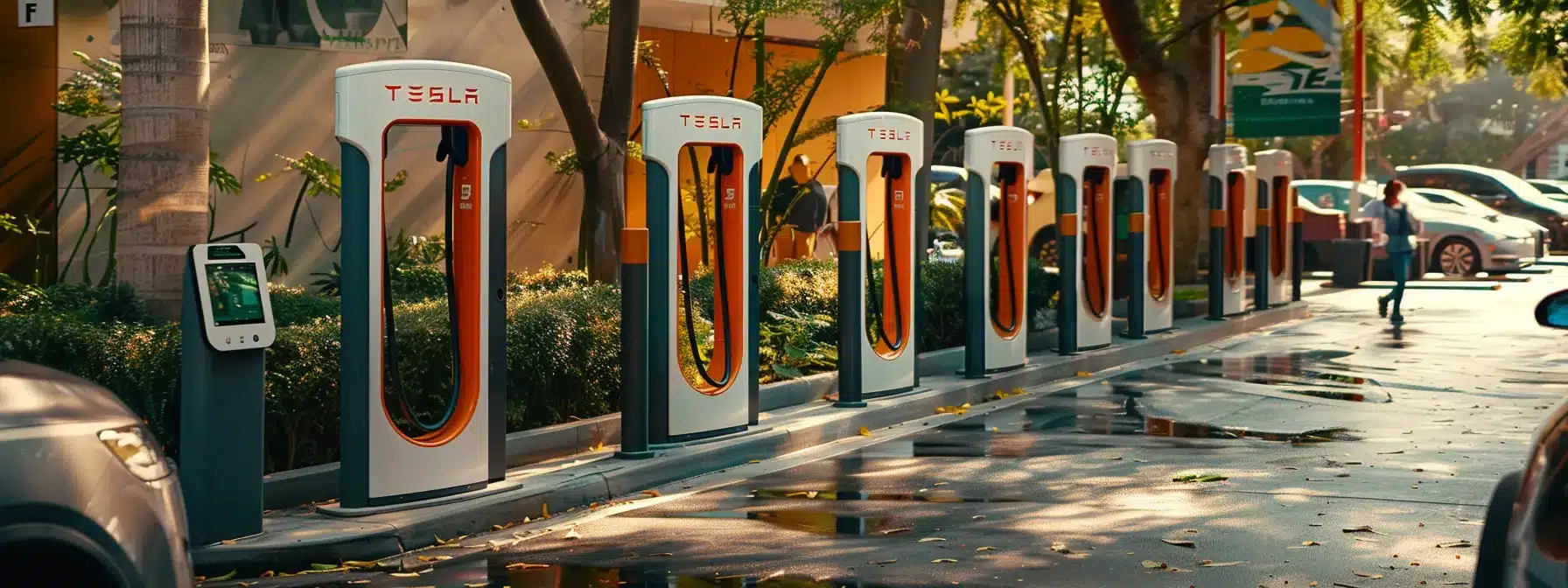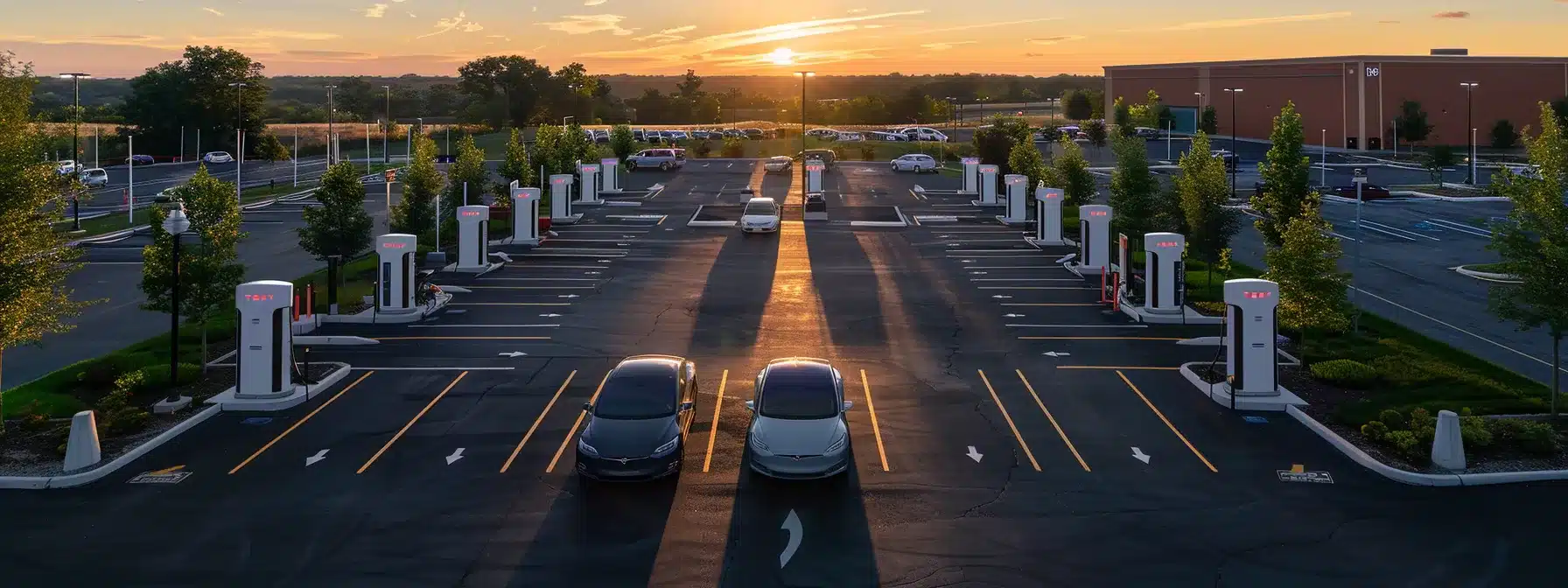Guide to Selecting Optimal Commercial EV Charging Solutions
As the demand for electric vehicles (EVs) rises, choosing the right commercial EV charging solutions can be overwhelming. With various types of charging stations available, businesses often struggle to understand which options deliver the best energy efficiency and user experience. This guide will explore key considerations, from essential warranty features to advanced analytics for optimizing charging stations and designing effective installations. By addressing these aspects, businesses can enhance engagement with users while ensuring compliance and maximizing return on investment. This article aims to simplify the process of selecting optimal charging stations, ultimately helping businesses thrive in the EV landscape.
Key Takeaways
- understanding different charger types is essential for effective commercial EV strategy
- integrating smart charging solutions enhances accessibility and operational efficiency
- evaluating user demographics supports tailored charging solutions and pricing models
- prioritizing maintenance ensures reliability and reduces downtime for charging stations
- aligning with sustainability goals enhances corporate reputation and meets consumer expectations
Understanding Different Types of Commercial EV Chargers

Understanding the various types of commercial EV chargers is crucial for businesses aiming to implement sustainable practices while enhancing electrical grid efficiency. This overview covers Level 1, Level 2, and DC Fast Chargers, comparing their charging speeds and applications. Additionally, it discusses connector types, including the SAE J1772 standard, smart chargers versus basic models, and selecting chargers based on specific business needs.
Level 1, Level 2, and DC Fast Chargers Overview
Level 1, Level 2, and DC Fast Chargers each serve distinct roles in the commercial electrification landscape of electric car transport. Level 1 chargers, which typically use standard 120-volt outlets, are suited for overnight charging at low cost, making them ideal for businesses with low turnover of vehicles. In contrast, Level 2 chargers offer faster charging times at 240 volts and are often employed in workplace parking lots to support smart charging solutions, accommodating the needs of employees who require a quick energy boost while at work. DC Fast Chargers, on the other hand, deliver substantial power through direct current, enabling electric vehicles to recharge significantly faster, which is crucial for high-traffic locations where efficiency and reduced wait times are the priorities:
- Level 1 chargers: Suitable for overnight charging.
- Level 2 chargers: Provide quicker charging, ideal for daily use.
- DC Fast Chargers: Support rapid charging for busy sites.
Comparing Charging Speeds and Their Applications
Charging speeds significantly impact the effectiveness of commercial EV charging solutions, making it essential for businesses to understand their unique applications. Level 1 chargers, while economical, are suited for properties where vehicles have ample overnight time to recharge, whereas Level 2 chargers are ideal for settings requiring a quick energy boost during employees’ work hours. For high-traffic areas, DC Fast Chargers streamline the process, often equipped with access control features and integrating with mobile apps for user convenience, ensuring scalability to meet growing demand while adhering to the Open Charge Point Protocol for compatibility across diverse EV models.
Connector Types and Vehicle Compatibility
Connector types play a critical role in determining vehicle compatibility within commercial EV charging solutions. The SAE J1772 standard is commonly used in North America, ensuring a wide range of electric vehicles can connect seamlessly to charging stations. Additionally, featuring technologies such as ISO 15118 can enhance communication between the vehicle and charger, enabling advanced functions like load balancing and dynamic pricing, which optimize energy usage and costs. Furthermore, chargers recognized with Energy Star certification promote energy efficiency, making them a smart choice for businesses looking to integrate energy storage solutions effectively. Understanding these connector standards and capabilities helps businesses select the right chargers that meet their fleet needs while maximizing operational efficiency.
Smart Chargers Versus Basic Models
Smart chargers are increasingly recognized for their enhanced accessibility and energy management capabilities compared to basic models. They incorporate features such as authentication protocols and load management systems that allow businesses to optimize charging times and costs, catering to varied user needs. By implementing smart charging solutions, companies can improve operational efficiency, provide better service to fleet operators, and adapt to the growing demand for commercial EV charging solutions:
- Enhanced accessibility for diverse users.
- Integration of load management and energy management systems.
- Authentication features for secure usage.
Selecting Chargers Based on Business Needs
Selecting the right commercial EV chargers based on specific business needs requires a careful assessment of factors such as demand response capabilities, automation for streamlined operations, and features like touchscreen interfaces for user engagement. Businesses should consider models that include Ethernet connectivity for network integration, enabling remote monitoring and control of charging stations. Additionally, exploring options that qualify for rebates can significantly reduce initial costs while enhancing the overall return on investment.
Now that the landscape of commercial EV chargers is clear, attention turns to the essential factors in selecting the right solution. What matters most when choosing an EV charging option? Let’s explore.
Key Considerations for Choosing EV Charging Solutions

Choosing the optimal commercial EV charging solutions requires a comprehensive approach that involves several key considerations. Assessing electrical infrastructure and power capacity ensures the selected chargers, whether Level 1 or DC Fast, can support the necessary voltage for efficient vehicle charging. Evaluating user demographics and charging habits helps in understanding customer needs, while integration with existing systems and software, including card reader functionalities, enhances operational efficiency. Additionally, customization and branding opportunities can improve user engagement, and reliable maintenance support options are essential for long-term effectiveness and cost control.
Assessing Electrical Infrastructure and Power Capacity
Assessing electrical infrastructure and power capacity is essential for businesses planning to install commercial EV charging solutions. Understanding the existing electrical system helps determine the capacity needed for various chargepoint options, ensuring that the infrastructure can support efficient electrification without interruption. Businesses also benefit from considering cable management strategies, which enhance usability and streamline operations, ultimately contributing to increased revenue through optimized charging station utilization.
Evaluating User Demographics and Charging Habits
Evaluating user demographics and charging habits is vital for businesses selecting commercial EV charging solutions. Understanding who will use the chargers, such as employees or customers, helps in developing a fee structure that accommodates varying needs. For example, a company might benefit from a turnkey solution that not only provides reliable charging but also includes an ev electrician to assist with installation and maintenance, ensuring that the system aligns with user patterns and maximizes user engagement.
Integration With Existing Systems and Software
Integrating EV charging solutions with existing systems and software is vital for businesses seeking to enhance operational efficiency. Effective integration allows for seamless management of charging stations through centralized software platforms, enabling real-time monitoring of usage and performance. Moreover, such systems can facilitate payment processing and user engagement, addressing potential pain points associated with customer access and billing, thus ensuring a smoother charging experience for all users.
Customization and Branding Opportunities
Customization and branding opportunities in commercial EV charging solutions allow businesses to create a distinctive identity that resonates with customers while enhancing user experience. By incorporating branding elements such as logos and color schemes onto charging stations, companies can promote their commitment to sustainability and innovation. Additionally, offering tailored features—like flexible payment options or loyalty programs—can further engage users and create a memorable charging experience:
- Integrate branding elements for recognition.
- Offer customized payment and loyalty options.
- Enhance user experience through tailored features.
Reliability and Maintenance Support Options
Reliability and maintenance support options are critical factors for businesses selecting commercial EV charging solutions. It is essential to choose chargers backed by manufacturers that offer robust maintenance plans and responsive customer service. Implementing proactive maintenance strategies can minimize downtime, ensuring that charging stations remain operational and accessible, which ultimately enhances user satisfaction and supports business objectives.
Choosing the right EV charging solution is just the first step. The real challenge comes with planning and installing those stations to make them work for you.
Planning and Installation of EV Charging Stations

Effective planning and installation of EV charging stations involve several critical considerations. Conducting a site assessment ensures optimal placement of chargers. Understanding permitting and regulatory requirements is essential for compliance. ADA compliance enhances accessibility for all users, while collaborating with certified installers guarantees quality workmanship. Additionally, addressing parking layout and traffic flow promotes efficient use of space and enhances user experience.
Conducting a Site Assessment for Optimal Placement
Conducting a thorough site assessment is essential for determining the optimal placement of EV charging stations in commercial environments. This process involves analyzing factors such as available electrical capacity, existing infrastructure, and expected user traffic patterns. For example, strategically positioning chargers near entrances or parking areas with high visibility can enhance accessibility and encourage usage, ultimately supporting the overall objectives of the business:
| Assessment Factor | Considerations | Impact |
|---|---|---|
| Electrical Capacity | Ensure adequate power supply for charging needs | Prevents overload and downtime |
| Location Visibility | Position near high-traffic areas | Enhances user engagement and accessibility |
| User Traffic Patterns | Analyze when and how users will access chargers | Optimizes charging station utilization and efficiency |
Understanding Permitting and Regulatory Requirements
Understanding permitting and regulatory requirements is essential for businesses planning to install EV charging stations. Each jurisdiction may have different codes and standards that dictate installation processes, safety measures, and accessibility features, such as ADA compliance. Failing to adhere to these regulations can result in delays, fines, or operational issues, emphasizing the importance of consulting local authorities and industry guidelines during the planning phase.
- Determine local codes and regulations.
- Ensure compliance with safety and accessibility standards.
- Consult local agencies for proper guidance.
Accessibility and ADA Compliance Considerations
Accessibility and ADA compliance are critical considerations when planning and installing EV charging stations in commercial settings. Ensuring that charging stations are accessible to individuals with disabilities is not only legally required but also demonstrates a commitment to inclusivity and customer service. By implementing features such as proper signage, appropriate height for controls, and sufficient space for wheelchair maneuverability, businesses can create an inviting environment that accommodates all users, thus enhancing overall customer satisfaction and usage rates.
Collaborating With Certified Installers
Collaborating with certified installers is essential for businesses looking to implement effective commercial EV charging solutions. Certified professionals bring expertise and knowledge of industry standards, ensuring that installations are done safely and efficiently while adhering to local regulations. Engaging these specialists not only improves installation quality but also provides businesses with the confidence that their charging stations will operate reliably for years to come:
- Understand the benefits of professional expertise.
- Ensure compliance with safety and regulatory standards.
- Experience peace of mind with reliable installations.
Addressing Parking Layout and Traffic Flow
Addressing parking layout and traffic flow is vital for effective installation of EV charging stations in commercial settings. By strategically placing charging units, businesses can alleviate congestion, enhance user accessibility, and improve the overall charging experience. For example, positioning charging stations near entrances or in high-traffic areas can reduce wait times and encourage usage, ultimately promoting a seamless integration of electric vehicle charging into daily operations.
- Plan charging station locations based on user traffic.
- Ensure design facilitates smooth vehicle movement.
- Optimize accessibility to enhance user satisfaction.
Installing EV charging stations is just the start. Understanding how to maximize return on investment will ensure those charging points pay off for years to come.
Maximizing Return on Investment for EV Charging

Maximizing return on investment for EV charging solutions involves several strategic approaches. Businesses can benefit from exploring incentives, grants, and tax credits that help offset initial costs. Developing pricing models and revenue strategies ensures profitability, while reducing operational costs with energy management enhances efficiency. Monitoring performance and usage analytics provides valuable insights, and effective marketing attracts EV drivers, ultimately supporting broader adoption.
Exploring Incentives, Grants, and Tax Credits
Businesses exploring commercial EV charging solutions can significantly maximize their return on investment by taking advantage of various financial incentives, grants, and tax credits available at federal, state, and local levels. These programs not only help offset the initial costs of installation but also contribute to long-term savings on operational expenses. For instance, some states offer tax incentives for businesses that install EV charging stations, while federal grants might support projects that promote clean energy initiatives, reducing the financial burden associated with transitioning to sustainable practices:
- Identify available federal, state, and local incentives.
- Calculate potential savings on installation costs.
- Evaluate grant opportunities for energy-related projects.
Developing Pricing Models and Revenue Strategies
Developing effective pricing models and revenue strategies is essential for businesses seeking to maximize return on investment (ROI) for their commercial EV charging solutions. By analyzing factors such as average charging time, energy rates, and customer demographics, businesses can create tiered pricing structures that cater to various user needs, ultimately enhancing profitability. For instance, implementing a pay-per-use model can attract a larger customer base, while offering subscription or membership plans may encourage frequent use among employees or regular customers:
| Pricing Model | Description | Benefits |
|---|---|---|
| Pay-Per-Use | Charge users based on the amount of energy consumed or time spent charging. | Attracts diverse users and generates revenue from infrequent customers. |
| Subscription Plans | Offer users a monthly fee for unlimited charging services. | Encourages loyalty and regular usage, securing predictable revenue. |
| Dynamic Pricing | Adjust rates based on demand, time of day, or energy costs. | Optimizes revenue during peak usage and incentivizes off-peak charging. |
Reducing Operational Costs With Energy Management
Reducing operational costs is a critical aspect of maximizing return on investment for commercial EV charging solutions. By implementing advanced energy management systems, businesses can monitor and optimize energy usage, leading to significant cost savings. For instance, utilizing demand response strategies allows companies to adjust charging schedules based on energy prices and grid demand, ultimately minimizing expenses while ensuring a reliable charging experience for users.
| Energy Management Strategy | Description | Benefits |
|---|---|---|
| Demand Response | Adjusts charging based on real-time energy prices. | Reduces energy costs during peak demand periods. |
| Load Balancing | Distributes energy consumption evenly across charging stations. | Prevents overload and enhances efficiency. |
| Renewable Energy Integration | Utilizes solar or wind energy sources for charging. | Lowers reliance on grid energy and reduces costs. |
Monitoring Performance and Usage Analytics
Monitoring performance and usage analytics is crucial for businesses investing in commercial EV charging solutions. By utilizing advanced analytics tools, companies can track charging patterns, user behaviors, and station utilization rates, facilitating the identification of trends and the development of effective strategies. This data-driven approach not only enhances operational efficiency but also helps organizations refine their pricing models and optimize energy management, thereby maximizing return on investment and ensuring the chargers meet the evolving needs of their users.
Marketing to Attract EV Drivers
Marketing to attract EV drivers requires a strategic approach that highlights the benefits of using commercial EV charging stations. Businesses should emphasize convenience, such as optimal charging locations and competitive pricing, while also showcasing sustainability initiatives that align with the values of eco-conscious consumers. Utilizing targeted advertising, social media engagement, and local partnerships can enhance visibility and drive interest among potential users, ultimately supporting a higher utilization of EV chargers and maximizing return on investment.
Investing wisely in EV charging is only part of the journey. Next, understanding compliance and preparing for the future will keep your operations strong and aligned with evolving standards.
Ensuring Compliance and Future Readiness

Ensuring compliance and future readiness is crucial for businesses selecting optimal commercial EV charging solutions. Staying updated with industry standards and regulations is essential for legal adherence. Implementing cybersecurity measures protects charging infrastructure, while preparing for technological advancements ensures longevity. Additionally, scaling solutions for growing demand and aligning with sustainability goals supports operational efficiency and corporate responsibility.
Staying Updated With Industry Standards and Regulations
Staying updated with industry standards and regulations is vital for businesses looking to implement commercial EV charging solutions successfully. This includes understanding local codes, safety measures, and compliance requirements, which can vary widely across jurisdictions. Regularly consulting with industry experts and attending relevant workshops can help ensure that businesses remain aligned with the latest developments, minimizing potential legal issues and enhancing the overall effectiveness of their charging infrastructure.
Cybersecurity Measures for Charging Infrastructure
In the evolving landscape of commercial EV charging solutions, implementing robust cybersecurity measures is essential to protect charging infrastructure from potential threats. This includes utilizing encryption protocols for data transmission, installing firewalls to prevent unauthorized access, and regularly updating software to patch vulnerabilities. By prioritizing cybersecurity, businesses can safeguard sensitive user information and ensure the reliability of their charging stations, addressing concerns related to data breaches and operational disruptions:
- Utilize encryption for data protection.
- Install firewalls to prevent unauthorized access.
- Regularly update software to patch vulnerabilities.
Preparing for Technological Advancements
Preparing for technological advancements involves selecting commercial EV charging solutions that can adapt to the evolving landscape of electric vehicle infrastructure. By opting for chargers equipped with software update capabilities and scalable features, businesses can ensure their systems remain relevant while accommodating future innovations such as vehicle-to-grid technology. This proactive approach not only streamlines operations but also enhances user experience, addressing the dynamic needs of an increasingly energy-conscious market.
Scaling Solutions for Growing Demand
Scaling solutions for growing demand is essential for businesses looking to enhance their commercial EV charging infrastructure. As electric vehicle adoption continues to rise, organizations must ensure their charging stations are capable of accommodating an increasing number of users without compromising service quality. Implementing modular charging systems allows for easy expansion, ensuring that as demand grows, businesses can seamlessly integrate additional chargers to meet user needs while maintaining efficient operations and compliance with industry standards.
Aligning With Sustainability Goals
Aligning with sustainability goals is critical for businesses investing in commercial EV charging solutions. By integrating energy-efficient technologies and utilizing renewable energy sources, companies can significantly reduce their carbon footprint while meeting the growing expectations of environmentally conscious consumers. For instance, implementing solar panels at charging stations not only decreases reliance on traditional energy sources but also promotes eco-friendly practices, ultimately enhancing corporate reputation and customer loyalty.
| Sustainability Initiative | Benefits | Implementation Example |
|---|---|---|
| Energy-Efficient Chargers | Reduces energy consumption and costs | Using Energy Star certified chargers |
| Renewable Energy Integration | Lowers carbon emissions and operating costs | Installing solar panels at charging locations |
| Smart Charging Solutions | Optimizes energy usage during peak times | Implementing load management systems |
Compliance lays the groundwork for what comes next. With a solid foundation, the focus shifts to enhancing user experience, beckoning engaging solutions that speak straight to the needs of the users.
Enhancing User Experience and Engagement

Enhancing user experience and engagement is crucial for the success of commercial EV charging solutions. This involves implementing user-friendly interfaces and payment systems, providing real-time charging status and notifications, and offering customer support for assistance. Additionally, incorporating user feedback can lead to improved services, while loyalty incentive programs can promote ongoing use of the charging stations.
Implementing User-Friendly Interfaces and Payment Systems
Implementing user-friendly interfaces and payment systems is essential for enhancing the overall experience at commercial EV charging stations. By utilizing intuitive touchscreen controls and streamlined payment methods, businesses can ensure that users engage with the charging process easily and efficiently. For example, integrating contactless payment options and mobile app functionality can significantly reduce wait times and user frustration, making it convenient for EV drivers to charge their vehicles with minimal hassle:
- Intuitive touchscreens for easy navigation.
- Contactless payment options for quick transactions.
- Mobile app integration for real-time updates.
Providing Real-Time Charging Status and Notifications
Providing real-time charging status and notifications is essential for enhancing user experience in commercial EV charging solutions. These features keep users informed about their charging progress, reducing uncertainty and wait times. For instance, mobile apps can alert users when their vehicle is fully charged or if there are any issues with the charging process, empowering them to manage their time effectively while ensuring seamless access to charging stations:
- Real-time updates increase user satisfaction.
- Mobile notifications help users manage charging times efficiently.
- Increased transparency builds trust in the charging network.
Offering Customer Support and Assistance
Offering robust customer support and assistance is essential for enhancing user experience at commercial EV charging stations. Businesses can establish dedicated help lines or chat services to address user inquiries and troubleshoot issues quickly. By providing comprehensive resources, such as FAQs and user guides, organizations help users navigate the charging process smoothly, ultimately fostering confidence and encouraging consistent use of their EV charging solutions.
Incorporating Feedback for Service Improvement
Incorporating user feedback is essential for the continuous improvement of commercial EV charging solutions. By actively seeking input from users regarding their experiences, businesses can identify areas for enhancement in functionality, accessibility, and overall satisfaction. For example, implementing surveys or feedback forms directly within charging stations or mobile apps allows companies to gather valuable insights that can lead to tailored upgrades and better service delivery:
- Establish a systematic feedback collection process.
- Analyze feedback to pinpoint areas for service improvement.
- Implement actionable changes based on user suggestions.
Building Loyalty Through Incentive Programs
Building loyalty through incentive programs is an effective strategy for businesses to encourage repeat usage of commercial EV charging stations. By offering rewards such as discounted charging rates, cashback from usage, or loyalty points redeemable for future services, companies can create a compelling reason for customers to return. This not only boosts the charging station‘s utilization rates but also aligns with the growing consumer preference for sustainable practices, further enhancing the overall user experience.
Conclusion
Selecting optimal commercial EV charging solutions is crucial for businesses seeking to enhance sustainability and operational efficiency. By understanding the different types of chargers, assessing infrastructure needs, and integrating smart technologies, organizations can effectively cater to user demands while maximizing their return on investment. Moreover, staying compliant with regulations and prioritizing user experience ensures reliable and accessible charging stations. Embracing these strategies positions businesses to thrive in the evolving landscape of electric vehicle adoption.

